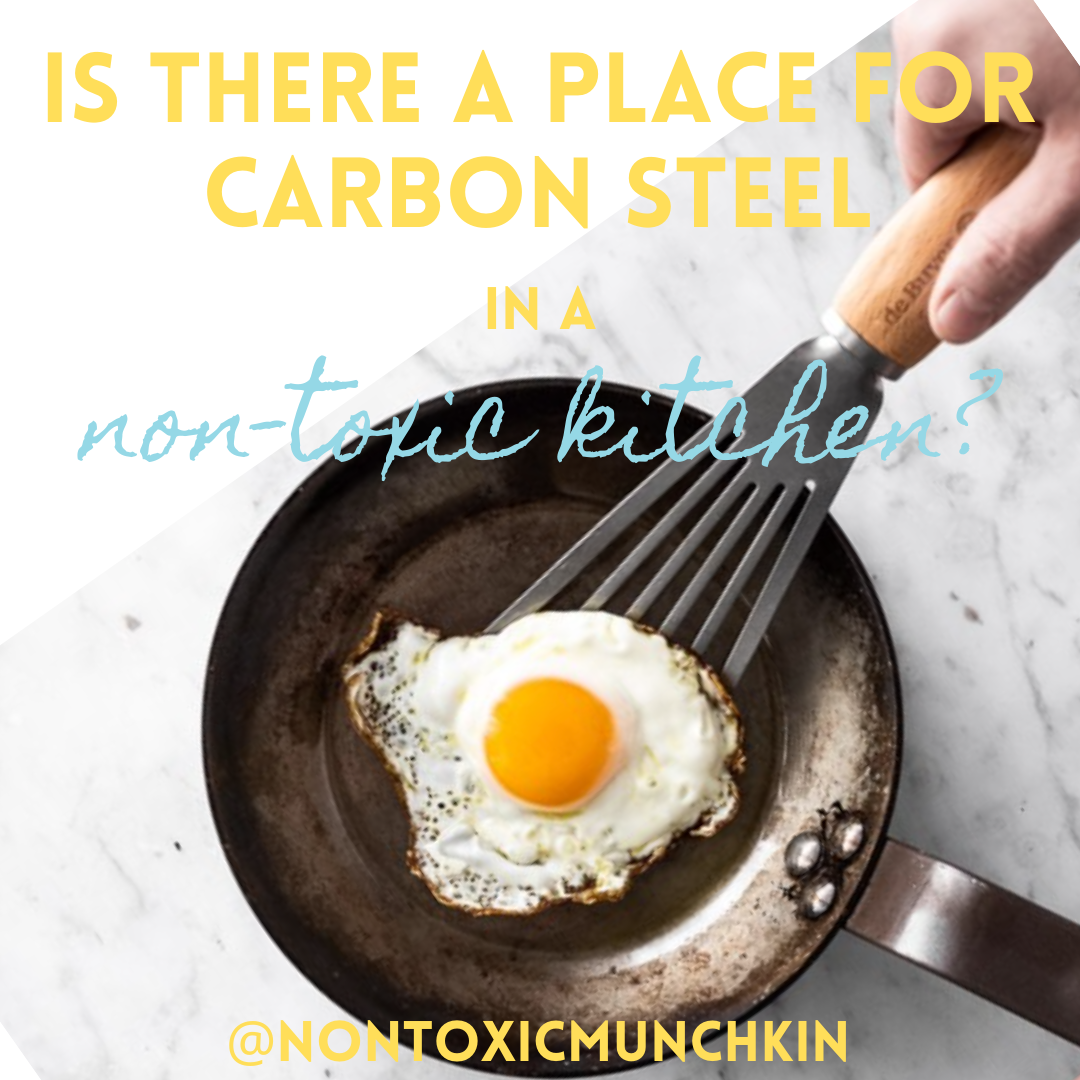Carbon Steel VS Cast Iron
For years I have recommended stainless steel, cast iron and glass for cookware. While these are the materials I use at home for cooking and recommend to my clients, it is important to understand that even with these materials, there are some potential leaching issues (cast iron can leach iron, stainless steel could leach a bit of nickel or chromium etc). This is why I highly recommend you stay away from just using ONE material in your kitchen; instead, mix things up and rotate your cookware among these safe alternatives ( I also have one ceramic pan made by Xtrema)
But, what about carbon steel? Is there a place for carbon steel in a non-toxic kitchen?
I’ll start with this disclaimer: I have not cooked with carbon steel and so cannot speak to its efficiency or ease or non-stick capabilities… for this article I am relying on user reviews and culinary trade reviews for those categories. This is more a review of carbon steel as a material from a toxicity stand point and a comparison to the pan which is most similar to it (and which I love) cast iron.
Composition:
Carbon Steel: Typically comprised of about 99% iron and 1% steel
Cast Iron: Typically comprised of 97-98% iron and 2-3% steel
Type of Iron
( ferric iron/ non-absorbable vs ferrous iron/ natural form in foods)
Carbon Steel: ferric iron
Cast Iron: ferric iron
Can it leach?
Carbon Steel: Yes, but…It can leach small amounts of iron. This can be favorable if you are anemic (I am) but if not, you should rotate pans with other safe options (which you should always do regardless!)
Cast Iron: Yes, but….it can leach small amounts of iron, while I have not seen any studies comparing the two it seems that cast iron would leach slightly less iron than carbon steel (carbon steel is more sensitive to acidic food… more below) This can be favorable if you are anemic but if not you should rotate pans with other safe options
Safe to cook everything?
Carbon Steel: Carbon steel is much more reactive to high acidic foods and will increase iron leaching if exposed. Avoid cooking highly acidic foods like tomato sauces and stews
Cast Iron: high acidic foods (like tomato sauce) should also be avoided. It will also leach more iron (although less than carbon steel)
Weight
Carbon Steel : lighter than cast iron cookware but heavier than stainless steel cookware. Careful with carbon steel pans that are too light and thin because these are known to warp
Cast Iron: heaviest. Their weight and thickness, however is what helps cast iron cook so evenly …. they are generally better at this than carbon steal
Non-stick qualities
Carbon Steel: while it requires you season it with oil…. because its surface is smoother than most cast irons most properly maintained carbon steel pans can be more non-stick than cast iron (but read how to care for them as this can make the difference between a very nonstick surface and a sticky disaster!)
Cast Iron: a well seasoned cast iron can also be virtually fully non-stick without any added chemicals
Heat Conductivity:
Carbon Steal: heats up and cools down much more quickly than cast iron. BUT
Cast Iron: Cast iron retains heat better. It will take longer to warm up and take longer to cool down, but at its peak, it will remain very hot for longer too which also helps cast iron cook evenly ….
Cleaning
Carbon Steel: Water and soap will strip the pan of its seasoning and will completely hinder its nonstick properties. Water and soap are the enemy of carbon steel. Really avoid using this and if you do use a little bit of water (never soap) dry thoroughly and place on stovetop to fully dry
According to the Made in Website, this is how to properly clean a carbon steel pan":
“When you finish cooking with your pan, gently wipe the pan clean with a paper towel or dishtowel. This will help collect any food remnants and absorb excess oil and fat.If you have food that's stuck or burnt to the pan's surface and its necessary to scrub, you'll need a little water to loosen the debris. Do NOT use soap and do NOT use a soaking bath. VERY GENTLY scrub the residue off with a bristle brush or sponge (not a scouring pad) and use a SMALL amount of water….When you’re done washing off food residue, dry your pan and put it over medium heat on your stovetop. This will help dry out any water or moisture left on the surface of the pan.
Cast Iron: Much more forgiving than carbon steel. Should ideally be cleaned with salt and minimal - if any- water. Always thoroughly dried. While exposing it to water can strip some of its hard earned seasoning (and thus non stick properties) - even a super rusted cast iron can be saved and brought back to glory.
Cost:
Carbon Steal costs slightly more than cast iron
Bottom Line?
Carbon steel is another safe, non-toxic alternative that you can feel good about adding to your cookware collection.
Its strengths seem to be cooking and searing items that do not need long exposure time to heat (ie stir fries and veggies - which is why carbon steel woks are so popular)
Examples:
BEST QUALITY CARBON STEEL
De Buyer Mineral B 12.6” frying pan.
Carbon Steel pan
Seasoned with beeswax
Made in France
$80
Mauviel Made In France M'Steel Black Steel Wok, 11.8", Steel
Seasoned with beeswax
Made in France
$114
AFFORDABLE CARBON STEEL
Lodge carbon steel 12 “ Skillet
Seasoned with vegetable oil
Made in the US
$40
https://www.researchgate.net/publication/260155210_Migration_Processes_of_Metal_Elements_from_Carbon_Steel_Cylinders_to_Food_Gases




